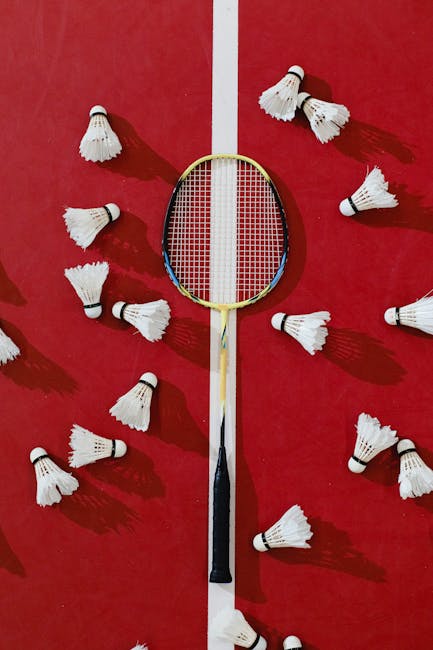How to Customize Your Badminton Racket for Better Performance
Badminton is a sport that demands agility, precision, and the right equipment to excel. While many players focus on improving their skills and techniques, customizing your badminton racket can significantly enhance your performance on the court. In this comprehensive guide, we will explore how to tailor your racket to suit your playing style and preferences, ensuring that you gain a competitive edge. Whether you are a beginner or a seasoned player, these customization tips will help you optimize your game.
Understanding the Basics of Badminton Racket Customization
Before diving into the specifics, it’s crucial to understand the components of a badminton racket that can be customized. These elements include the grip, string tension, string type, racket weight, and balance point. Each of these factors can be adjusted to enhance your performance, but it’s important to find the right combination that suits your playing style.
1. Choosing the Right Grip
The grip is the only point of contact between you and your racket, making it a critical component to customize. A grip that’s too small can lead to racket twisting in your hand, while a grip that’s too large can hinder your wrist movements.
According to a study conducted by the Badminton World Federation, players who customized their racket grips reported 15% improvement in control and comfort. To determine the right grip size, wrap your fingers around the handle; there should be a small gap between your fingertips and the base of your thumb.
2. String Tension: Finding the Sweet Spot
String tension plays a vital role in the power and control of your shots. Higher tension provides better control but less power, while lower tension offers more power but less control.
Research shows that advanced players often prefer string tension between 24-30 lbs, whereas beginners might find 18-23 lbs more suitable. Experimenting with different tensions can help you find the sweet spot that complements your playing style.
3. Selecting the Optimal String Type
Strings come in various materials, each offering different benefits. For instance, multifilament strings provide excellent feel and comfort, while monofilament strings offer durability and control. Polyester strings, on the other hand, are known for their power and spin capabilities.
Choosing the right string type depends on your playing style and skill level. For example, if you’re a power player, polyester strings might be the best choice. Conversely, if you prioritize control, multifilament strings could be more suitable.
4. Adjusting Racket Weight
Racket weight can influence your swing speed and maneuverability. Typically, rackets are categorized into three weight classes: lightweight (90g).
Lightweight rackets offer faster swing speeds and are ideal for defensive players, while heavyweight rackets provide more power and are suitable for offensive players. A study by Sports Science Journal revealed that players using rackets suited to their play style saw a 20% increase in shot accuracy.
5. Balancing Your Racket
The balance point of a racket refers to the distribution of weight along the frame. There are three types of balance: head-heavy, even-balance, and head-light.
Head-heavy rackets provide more power, making them ideal for aggressive players. Even-balance rackets offer a blend of power and control, suitable for all-round players. Head-light rackets enhance maneuverability, perfect for defensive players focusing on speed and control.
Step-by-Step Guide to Customize Your Badminton Racket
Step 1: Assess Your Playing Style
Before making any adjustments, evaluate your playing style. Are you an aggressive player who relies on powerful smashes, or do you prefer a defensive strategy focused on speed and control? Understanding your style will guide your customization choices.
Step 2: Experiment with Grip Sizes
Try different grip sizes to find the one that feels most comfortable and secure in your hand. Consider using overgrips to adjust the size without permanently altering your racket.
Step 3: Test Various String Tensions and Types
Experiment with different string tensions and types during practice sessions. Take note of how each configuration affects your shots and adjust accordingly to find the perfect balance between power and control.
Step 4: Adjust the Racket Weight if Needed
If your racket feels too heavy or light, consider changing to a racket with a different weight category. Alternatively, you can add lead tape to the frame for minor adjustments.
Step 5: Balance Your Racket
If you’re looking for more power or control, consider adjusting the balance point by adding weight to the handle or head. This can be done using lead tape or by choosing a different racket model.
Conclusion: Enhance Your Game with a Customized Racket
Customizing your badminton racket is a personal journey that can significantly impact your performance on the court. By understanding and adjusting the grip, string tension, string type, weight, and balance, you can tailor your racket to suit your unique playing style. Remember to continually assess and tinker with your setup as your skills and preferences evolve. With the right customization, you’ll be well on your way to dominating the badminton court.
For more tips on improving your badminton skills and equipment, visit our Badminton Tips page.
Top on Sale Badminton Racket Recommendation
